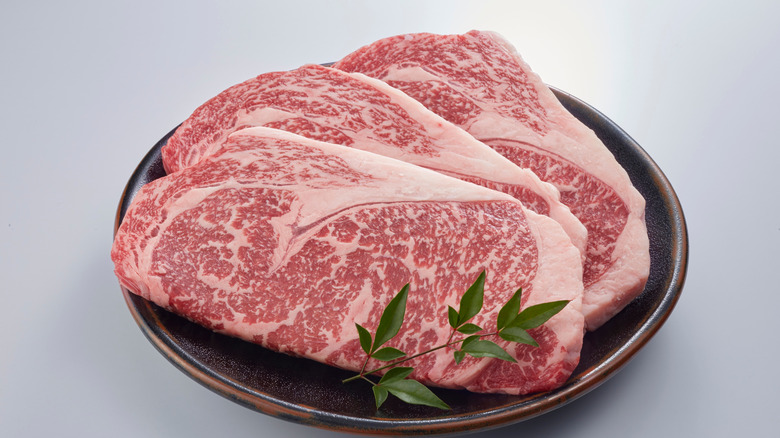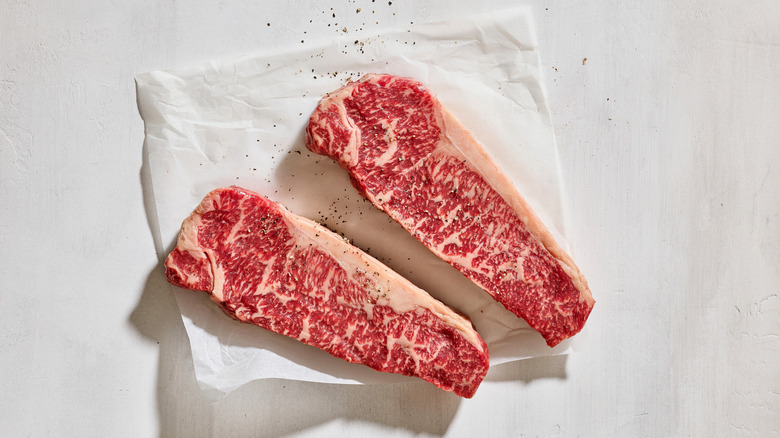This Is One Of The Key Differences Between Australian And Japanese Wagyu Beef
When selecting a meat to cook with, the details of butchering understandably take priority. After all, you'll want to avoid buying the toughest cut of steak, and instead focus on tender, flavorful meat. However, other factors like the cow's diet and breed also impact the resultant dining experience. And few beef types translate such qualities more prominently than wagyu.
The term refers to several types of Japanese cow breeds, most famously known for their incredible marbling and delicate flavors. In addition to following a specific bloodline, the animals are raised in accordance with rigid environmental and dietary conditions, ensuring that the expensive beef is worth the price tag. And while the vast majority of full-blood wagyu raising occurs in Japan, the second largest volume exists in Australia.
The land down under is also home to several wagyu breeds, with Japanese Black the most common type, just like in Japan. Yet despite the many similarities between wagyu cattle-raising practices, there are also some key differences. And one of the most critical details comes down to the diet. Australian wagyu are fed mainly grass and finished with grain, while Japanese cows eat through diverse products like soybeans, rice, straw, yeasts, greens, as well as supplements, specially segmented over their lifetime. Subsequently, the two nations' cattle herds offer a distinct culinary experience.
Australian wagyu beef are usually fed more grass
Although Australian wagyu beef was imported from originally Japanese-born breeds, the raising conditions create quite a different kind of meat. Here, grass is more frequently incorporated into the cattle's diet. Opposed to the specialized feed in Japan, Australian wagyu cows often grow up grazing in fields. Then, for approximately the last year of their life, the cows consume grains like their Japanese counterparts. Common cereals like corn and wheat constitute the typical diet. Furthermore, while Japanese wagyu cows almost exclusively inhabit small-scale operations, large herds of wagyu cows exist in Australia. Such animals likely receive more hands-off care, with less tailored supplemental programs.
All such factors — compounded with nuances in the breed — translate to Australian wagyu beef's different flavor. Grass-fed beef tastes different, and Aussie cows accordingly boast a more classic, meaty flavor. Such wagyu still comes with eye-catching marbling, but as with other grass-fed beef, there's a little less fat. So you can also expect cuts to be more muscular. Australian wagyu beef is certainly still delicious, but take note of the dietary nuance.
Expect more specialized feeding with Japanese wagyu beef
Further north in Japan, wagyu beef diets follow quite a different protocol. Japanese cows dine on a specific schedule of eating according to their age, blending together numerous food sources. Only pregnant cows and breeding bulls eat from the pasture, while other cattle follow a dedicated diet plan. Calves usually start with hay and rice plants, until a bit over a year in, when grain-based compound feeds are introduced. Such complex nutritional mixes come packed with proteins, minerals, and vitamins.
As a result, Japanese wagyu beef achieves its trademark dense marbling by consuming mainly grains, but of many types. Opposed to Australian wagyu, you can expect a more savory quality, with added tenderness. The palate's more delicate, taking on a butter-like flavor. And the tasting notes turn even more delicate when differentiated into the subcategory of Kobe versus wagyu beef.
This extra special meat type — which emerges from a specific bloodline constrained to the Hyōgo prefecture — entails even more stringent regulation. So, accordingly, you can expect an even more specialized diet. Like with wagyu, their food intake consists of a complex medley of scheduled ingredients, with no reliance on pasture grass. Such added meticulousness translates exquisitely savory flavor; think aromatic, sweet, and nutty undertones as well as a mouthwatering beef fattiness. Although constituting a minuscule portion of wagyu production, intricately flavored Kobe showcases a character even more distinct from Australian wagyu.



